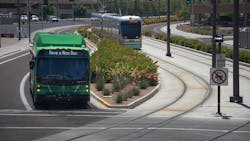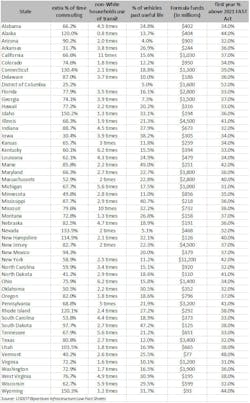Bipartisan Infrastructure Deal: How transit systems in each state can benefit
The U.S. Department of Transportation (USDOT) released fact sheets for all 50 states, plus the District of Columbia, showing how the Bipartisan Infrastructure Deal that was signed into law by President Joe Biden on Nov. 15, 2021, will benefit each one.
The fact sheets cover federal money that has been included for roads and bridges, roadway safety, airports, building an electric vehicle charging network and improved mobility options, such as through public transportation and passenger rail.
"Americans rely on our transportation infrastructure every day – to get to work, school, loved ones and to move goods across our economy,” said Secretary of Transportation Pete Buttigieg. “The once-in-a-generation investments in the Bipartisan Infrastructure Law will improve people’s lives in every state in the nation by increasing access to safe, clean, reliable transportation.”
Transit highlights
To outline each state’s expected transit benefit, the USDOT fact sheets focus on five areas: the percentage of extra time spent commuting via public transit, the likelihood of non-White households to use transit, the percentage of transit vehicles in a state that are past their useful life and the increase in expected formula funds each state could see as compared to the final year under the FAST Act.
Non-White households in California and Missouri are more likely to use public transit, at 11 times more likely and 10 times more likely, respectively. Non-White households in Ohio and Kentucky are both 6.2 times more likely to use transit.
The Federal Transit Administration estimates the bill will help reduce the current transit maintenance backlog by 15 percent. The bill includes $23.1 billion for the State of Good Repair program, $5.6 billion in Low or No Emission Vehicle Competitive Grants and establishes a new Rail Vehicle Replacement Grants program with $1.5 billion in funding. These programs will assist agencies in their efforts to modernize and replace fleets.
Using the information from the USDOT fact sheets, on average, 21.5 percent of transit fleets are past their useful life. USDOT says 49 percent of Maine’s transit vehicles are past their useful life, 47.2 percent of South Dakota’s and 40.7 percent of Mississippi’s, while less than 10 percent of the transit vehicles in Georgia, Nevada, Arizona and the District of Columbia are past their useful life.
Significant increase in formula funds
The five-year bill increases total funding for Urbanized Area Formula Grants by $8.9 billion to $33.5 billion and increases funding for Rural Formula Grants by $1.2 billion to $4.6 billion. These funds help improve transit and mobility options. Formulas that determine grant funding are tied to the results of the 2020 U.S. Census and could change.
On average, states can expect to see a 36.6 percent increase in formula transit funding in the first year under the Bipartisan Infrastructure Deal versus FAST Act authorized funding – all states will see at least a 31 percent increase. Based on current formulas, the District of Columbia will see the highest increase in first year funds, with an expected 52 percent increase in funding versus what was provided under the FAST Act. Massachusetts, New Hampshire, North Dakota, Illinois, Pennsylvania, New York, Maine, Alaska, Wyoming and Vermont are expected to see increases of more than 40 percent in their formula grants.
The individual fact sheets for each of the 50 states and the District of Columbia can be viewed at USDOT’s website.
About the Author

Mischa Wanek-Libman
Group Editorial Director
Mischa Wanek-Libman is director of communications with Transdev North America. She has more than 20 years of experience working in the transportation industry covering construction projects, engineering challenges, transit and rail operations and best practices.
Wanek-Libman has held top editorial positions at freight rail and public transportation business-to-business publications including as editor-in-chief and editorial director of Mass Transit from 2018-2024. She has been recognized for editorial excellence through her individual work, as well as for collaborative content.
She is an active member of the American Public Transportation Association's Marketing and Communications Committee and served 14 years as a Board Observer on the National Railroad Construction and Maintenance Association (NRC) Board of Directors.
She is a graduate of Drake University in Des Moines, Iowa, where she earned a Bachelor of Arts degree in Journalism and Mass Communication.

